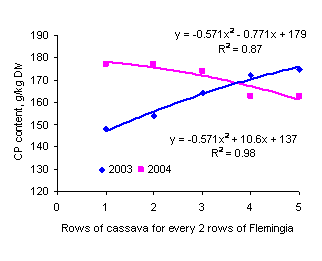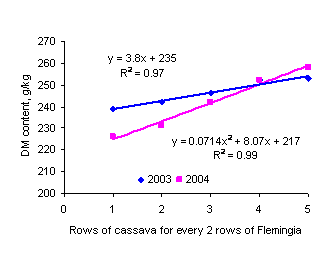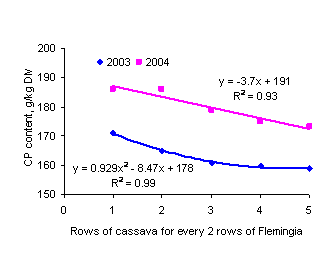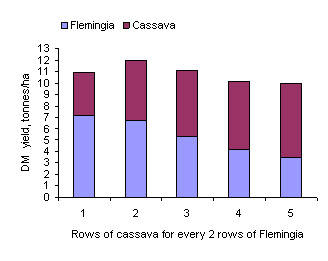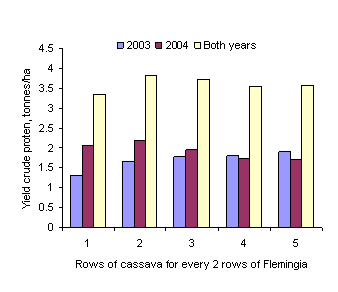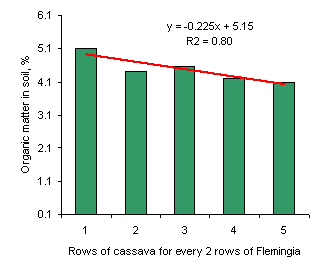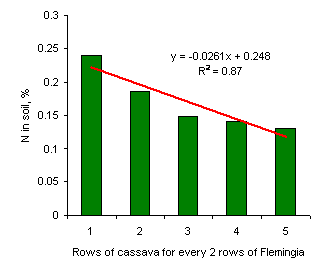Effect of increasing area of cassava (Manihot esculenta
Crantz) relative to Flemingia (Flemingia macrophylla) on biomass yield,
soil fertility and soil erosion
Ngo Tien Dzung and T R Preston*
Goat and Rabbit Research Center, Sontay, Hatay, Vietnam
dzungvbdp@yahoo.com
* University of Tropical Agriculture, TOSOLY, AA #48 Socorro, Colombia
Abstract
An experiment was carried out at the
Goat and Rabbit Research Center, Sontay, Hatay, Vietnam, from February 2003 to
November 2004 to measure effects on biomass yield, soil fertility and soil
erosion in response to increasing ratio of rows of cassava rows to rows of the
leguminous shrub Flemingia macrophylla in an inter-cropping system. Two
rows of Flemingia were associated with 1, 2, 3, 4 and 5 rows of cassava.
Flemingia was planted first and cassava 14 days later. Fertilizer was applied in
the form of organic manure (from mixed cattle and buffalo excreta) before
planting at the rate of 2 kg/m2
fresh weight in the first year and the same amount again in March the second
year. No other fertilizers were applied during the experimental period. The
first harvest was made when the cassava reached 100 cm in height and subsequent
harvests of the re-growth from 56 to 75 days. All the foliages were removed at
30 cm above ground level.
Biomass yield of cassava and
Flemingia in an inter-cropping system was improved by increasing the number of
cassava rows relative to cassava in the first year, but decreased slightly in
the second year. The maximum biomass yield was obtained in the system with 2
rows of cassava and two rows of Flemingia. The crude protein contentof the
cassava foliage deceased as the area of cassava rlative to Flemingia increased.
Soil fertility over a 24 month period increased in the plots with the highest
ratio of Flemingia and decreased as the ratio of cassava to Flemingia was
increased. Protein content in the cassava foliage decreased linearly with
decreased in soil fertility. Soil erosion was high in all plots in the first
year and was directly related to the relatve area planted with Flemingia. In the
second year soil eroson was much less and was inversely related to the
proportion of Flemingia n the inter-cropping system.
It is concluded that the optimum
ratio of Cassava to Flemingia, in terms of biomass yield and maintenance of soil
fertility, is two rows of each planted alternately.
Keywords: Biomass, bio-test, cassava, Flemingia, foliage, inter-cropping,
soil fertility, soil erosion
Introduction
Cassava or tapioca (Manihot esculenta, Crantz)
is an annual root crop grown widely in tropical and sub-tropical areas. It is a
cash crop cultivated by smallholder farmers within the existing farming systems
in many countries. Cassava can also be cultivated in combined forage/root
systems with two or more harvests of the foliage prior to letting the root
develop to maturity (Wanapat et al 1997). More recently, efforts have been
concentrated on managing cassava as a perennial forage crop with repeated
harvesting at 2 to 3 months intervals (Preston et al 2000; San Thy and Preston
2000). However, cassava is an exploitive crop when grown in monoculture and
repeated planting in the same soil leads to loss of soil fertility and erosion (Binh
et al 1998; Polthanee et al 2001; Nguyen Phuc Tien et al 2003).
Recent research has focused on ways to maintain
yield and soil fertility by recycling of manure and biodigester effluent
(Preston 2001) or the association with shrub legumes such as Gliricidia
sepium and Desmanthus virgatum (Preston et al 2000),
Flemingia macrophylla (Ngo Tien Dzung et al 2003; Nguyen Phuc Tien et al
2003) and cow pea (Polthanee et al 2001).
Flemingia macrophylla is a leguminous shrub
with high biomass yields that grows well in acid soils (Binh et a 1998).
Flemingia can improve soil fertility though return to the soil of organic matter
from fallen dead leaves and by nitrogen fixation (Binh et al 1998; Andersson
2002). The wooden stems can also be used as fuel (Binh et al 1998). The foliage
of Flemingia is relatively high in crude protein (about 17% in dry matter) but
it can only replace about 15% of the diet of growing goats because of low
palatability and low digestibility (Binh et al1998; Mui et al 2002).
Recent research indicates that planting Flemingia
and cassava in alternate double rows is better than alternate single rows in
terms of total biomass yield, maintenance of soil fertility and reduced soil
erosion, and that both these associations are superior to growing of cassava in
monoculture (Ngo Tien Dzung 2003).
The objective of the present study was to compare
biomass yield, soil fertility and soil erosion in differrent systems of
inter-cropping between cassava and Flemingia. The hypotheses to be tested were:
-
Biomass yield in an inter-cropping system of cassava and Flemingia will be improved by increasing the number of cassava rows from 2 to 3, 4 or 5 rows, for every 2 rows of Flemingia.
-
Soil fertility will be maintained even with the highest ratio of cassava in the association.
Material and methods
Location and climate
The experiment was carried out from February 2003 to
December 2005 on sloping land at 105o25' E and 21o06' N,
220m above sea level in the Bavi region, Hatay province, North Vietnam. The soil
characteristics and composition at the experimental site were: pHKCl
4.24, organic matter (OM) 4.64%, Ntotal: 0.17%, K2Ototal
0.48% and P2O5 total 0.052%. In general, the soil is acid
with low fertility and the OM has been reduced by erosion. Drought occurs
frequently in the area.
The climate in the area is tropical- monsoon, with a
wet season between April and November and dry season from December to March.
Annual rainfall was 1874mm in 2003 and 1756mm in 2004 with a mean daily
temperature from 19.7 to 31.5oC.
Treatments and experimental design
There were five treatments:
2FM-1CF: Two rows of Flemingia associated with 1 row
of cassava
2FM-2CF: Two rows of Flemingia associated with 2
rows of cassava
2FM-3CF: Two rows of Flemingia associated with 3
rows of cassava
2FM-4CF: Two rows of Flemingia associated with 4
rows of cassava
2FM-5CF: Two rows of Flemingia associated with 5
rows of cassava
The plots were each 10*20m (200 m2)
arranged as a randomized complete block design with 4 replications on 5000 m2
of sloping land.
Crop establishment, management and measurements
Planting
The Flemingia was planted with 50 cm between the two
rows and 5 cm between seeds. The cassava was planted with 50 cm between rows and
15 cm between stem cuttings (length of stem cutting was 20 to 25 cm). The
cassava was planted first followed 14 days later by the Flemingia. Organic
manure (from pigs, cattle and buffalo) was applied before planting and after 6
months of planting at the rate of 2 kg/m2. No other fertilizer was
applied during the experimental period, which lasted for 2 years. Manure
application was the same in all plots.
Harvesting
The first harvest was made when the cassava or
Flemingia reached 100 cm in height (about 3 months after planting), all the
foliage being removed at 30 cm above ground level. The same pattern was followed
for the re-growth (about every 75 days). In each plot, 5 randomized sub-plots
(4*4 m = 16m2) were chosen to estimate biomass yield, which was
calculated as an average of the 5 sub-plots. The sub-plots were chosen without a
zone around them. The roots from the cassava were harvested at the end of the
two years of the experiment.
Measurements
Samples of foliage (Flemingia and cassava) and of
cassava roots were taken from each of the 5 sub-plots and mixed prior to
analysis for dry matter (DM) and nitrogen (N).
Soil sampling and biological test of soil fertility:
Biological test for soil fertility and soil analysis
At the beginning, and at 6-month intervals, samples
of soil were taken from the plots for biological test of soil fertility (Mui et
al 1996; Boonchan Chantaprasarn and Preston 2004) and for soil analysis. The
soil samples were taken from each of the 5 sub-plots which were then bulked for
each treatment/replicate. The growth periods of the maize in the biological test
were 35 days in the summer season and 42 days in the winter season.
Soil erosion
At the lower limit of each plot, a canal system was
established following the contour. The canals were 60 cm deep, 60 cm wide and 10
m long, and were lined by plastic sheet to catch the soil that was washed away.
The soil loss was weighed after each rainfall according to the procedure
described by Hudson (1981).
Chemical analysis
The samples of the foliages, and the cassava roots,
were analysed according to AOAC (1990) for DM and crude protein. Samples of soil
were analysed for pHKCl (KCl 0.1M), OM, N, P
and K, according to AOAC (1990).
Statistical analysis
The data were analysed statistically using the GLM
procedure of the Minitab Software, version 13.1 (Minitab 2000). The treatment
means which showed significant differences at the probability level of P<0.05
were compared with each other using Tukey's pair-wise comparison procedure
(Minitab 2000). The model used in the analysis was:
Yij = µ + Ti +Bj + (TB)ij + eij
Where: Yij is dependent variable, µ the overall
mean, Ti: treatment (i= 1,...5), Bj: block (j = 1; …4), (TB)ij: interaction
between treatment and block and eij the experimental error
Results and discussion
Chemical composition of cassava and Flemingia foliages
There were contrasting results for composition of Flemingia and cassava foliage in the two years (Table 1).
|
Table 1: Mean values for content of DM and crude protein (CP) in the foliage of cassava and Flemingia in each of the two years |
||||
|
|
Flemingia |
Cassava |
||
|
DM, g/kg |
CP, g/kg DM |
DM, g/kg |
CP, g/kg DM |
|
|
Year 2003 |
|
|
|
|
|
250a |
148 |
239 |
171 |
|
|
2FM-2CF |
249a |
154 |
242 |
165 |
|
2FM-3CF |
240ab |
164 |
246 |
161 |
|
2FM-4CF |
223ab |
172 |
252 |
160 |
|
2FM-5CF |
212b |
175 |
253 |
159 |
|
SE mean |
6.0 |
4.5 |
7.2 |
3.7 |
|
Year 2004 |
|
|
|
|
|
2FM-1CF |
237a |
177a |
226 |
186 |
|
2FM-2CF |
246ab |
177a |
231 |
186 |
|
2FM-3CF |
250ab |
174a |
242 |
179 |
|
2FM-4CF |
256b |
163b |
252 |
175 |
|
2FM-5CF |
256b |
163b |
258 |
173 |
|
SE mean |
3.9 |
2.1 |
6.7 |
3.4 |
|
a, b Means within columns within years, without common superscripts differ at P<0.05 |
||||
As the ratio of cassava to Flemingia increased,
there were increases in crude protein and decreases in DM content of the
Flemingia foliage in the first year (2004) while the opposite trends were
observed in the second year (Figures 1 and 2). By contrast, the DM content of
cassava foliage increased and the crude protein decreased in both years as the
ratio of cassava to Flemingia was increased (Figures 3 and 4).
|
|
|
|
|
Figure 1: Effect of treatment (rows of cassava relative to
2 rows of Flemingia) on DM content of foliage of Flemingia in each of the two
years |
|
Figure 2: Effect of treatment (rows of cassava relative
to 2 rows of Flemingia) on CP content of foliage of Flemingia in each of the two
years |
|
|
|
|
|
Figure 3: Effect of treatment (rows of cassava relative to
2 rows of Flemingia) on DM content of foliage of cassava in each of the two
years |
|
Figure 4: Effect of treatment (rows of cassava relative
to 2 rows of Flemingia) on CP content of foliage of cassava in each of the two
years |
Biomass yield
In the first year, biomass yield of Flemingia was
low but increased in the second year (Table 2; Figures 5 and 6). In both years
the maximum yield of biomass DM and crude protein was recorded for the treatment
of 2 rows Flemingia; 2 rows cassava (Figures 7 and 8). In the second year, yield
of DM and crude protein decreased linearly as the ratio of cassava to Flemingia
increased (Figures 7 and 8). In the optimum treatment (2 rows Flemingia: 2 rows
cassava) total biomass yield was higher in the second year. A similar finding
was reported by Nguyen Phuc Tien et al (2003).
|
Table 2: Mean values for yield (tonnes/ha) of DM and crude protein in foliages of cassava and Flemingia in each of the two years |
||||||
|
|
2FM-1CF |
2FM-2CF |
2FM-3CF |
2FM-4CF |
2FM-5CF |
SEM/P |
|
Year 2003 |
|
|
|
|
|
|
|
DM |
8.14a |
10.31b |
11.03c |
11.16cd |
11.72d |
0.15/ |
|
Flemingia |
3.50a |
3.40a |
2.85b |
2.21c |
1.67d |
0.075/ |
|
Cassava |
4.63a |
6.91b |
8.18c |
8.95d |
10.06e |
0.113/ |
|
Crude protein |
1.31a |
1.66b |
1.78c |
1.81cd |
1.89d |
0.025 |
|
Flemingia |
0.52a |
0.52a |
0.47b |
0.38c |
0.29d |
0.012 |
|
Cassava |
0.79a |
1.14b |
1.31c |
1.43d |
1.60e |
0.018 |
|
Year 2004 |
|
|
|
|
|
|
|
DM |
11.32a |
11.99b |
11.06a |
10.15c |
10.00c |
0.164 |
|
Flemingia |
7.62a |
6.72b |
5.30c |
4.12d |
3.43e |
0.115 |
|
Cassava |
3.69a |
5.26b |
5.76c |
6.03c |
6.56d |
0.090 |
|
Crude protein |
2.04a |
2.17b |
1.95a |
1.72c |
1.69c |
0.029 |
|
Flemingia |
1.34a |
1.18b |
0.92c |
0.67d |
0.56e |
0.019 |
|
Cassava |
0.69a |
0.98b |
1.03b |
1.05b |
1.13c |
0.016 |
Two years |
|
|
|
|
|
|
DM |
19.46a |
22.31b |
22.10b |
21.32b |
21.72b |
0.308 |
Crude protein |
3.35a |
3.83b |
3.73bc |
3.54ac |
3.58c |
0.052 |
|
a bc Means within rows, within years, without common superscripts differ at P<0.05 |
||||||
|
|
|
|
|
Figure 5: Effect of treatment (rows of cassava relative
to 2 rows of Flemingia) on DM yield of foliage of Flemingia and cassava in 2003 |
|
Figure 6: Effect of treatment (rows of cassava relative
to 2 rows of Flemingia) on DM yield of foliage of Flemingia and cassava in 2004 |
|
|
|
|
|
Figure 7: Effect of treatment (rows of cassava relative to
2 rows of Flemingia) on DM yield of foliage (combined Flemingia and cassava) in
2003, 2004 and for both years |
|
Figure 8: Effect of treatment (rows of cassava relative to
2 rows of Flemingia) on crude protein yield of foliage (combined Flemingia and
cassava) in 2003, 2004 and both years |
Soil fertility
Soil fertility as measured by the maize "bio-test" increased with time over 24 months for treatments 2FM:1CF and 2FM:2CF but declined for the treatments with 4 or 5 rows of cassava per 2 rows of Flemingia (Table 3 and Figure 9). Other measures of soil fertility (organic matter and N content) also showed a linear decline as the ratio of cassava to Flemingia increased (Figures 10 and 11).
|
Table 3: Least square means for weight of root and green biomass of maize plants grown in soil from the experimental plots (g/pot) |
||||||
|
|
2 FM-1CF |
2FM-2CF |
2FM-3CF |
2FM-4CF |
2FM-5CF |
SE |
|
Beginning |
32.8 |
34.7 |
33.7 |
32.9 |
33.2 |
2.20 |
|
6 months |
36.5 |
35.1 |
34.9 |
33.4 |
33.6 |
1.50 |
|
12 months |
37.25a |
36.81a |
34.0ab |
31.7b |
29.6b |
1.32 |
|
18 months |
39.9a |
37.1ab |
33.9b |
30.7b |
30.6b |
1.56 |
|
24 months |
40.1a |
38.1a |
34.8ab |
31.6b |
28.7b |
1.47 |
|
a, b Means within rows without common superscript differ at P<0.05 |
||||||
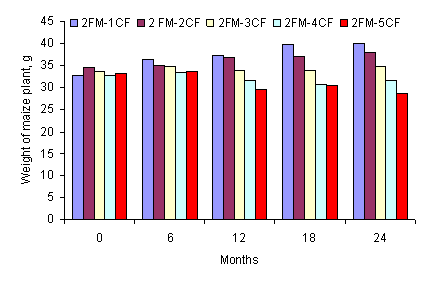
Figure 9: Changes in soil fertility with time
according to ratio of Flemingia to cassava
|
|
|
|
|
Figure 10. Changes in organic matter in soil according
|
|
Figure 11. Changes in N content of soil according |
The protein content of the cassava foliage was
positively related with soil fertility (Figure 12).
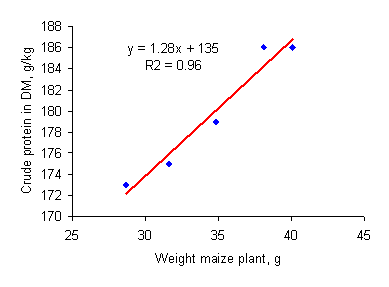
Figure 12: Relationship between relative soil fertility (according to
maize biotest)
and crude protein content of foliage of cassava (end year 2004)
In the first year, soil erosion varied inversely
with the ratio of Flemingia to cassava as growth of the Flemingia was slower
than that of the cassava leading to reduced soil cover in plots with highest
proportion of Flemingia (Table 4 and Figure 13). The opposite effect was
observed in the second year when soil loss was lower in all plots compared with
the first year and increased linearly as the proportion of cassava in the plots
increased.
|
Table 4: Least square means for parameters of soil fertility |
||||||
|
|
2FM-1CF |
2FM-2CF |
2FM-3CF |
2FM-4CF |
2FM-5CF |
SE |
|
Beginning |
|
|
|
|
|
|
|
pHKCl |
4.30 |
4.26 |
4.22 |
4.30 |
4.24 |
0.032 |
|
OM, % |
4.69 |
4.10 |
4.76 |
4.39 |
4.75 |
0.259 |
|
N % |
0.16 |
0.17 |
0.165 |
0.155 |
0.162 |
0.015 |
|
P2O5, % |
0.055 |
0.041 |
0.051 |
0.036 |
0.090 |
0.015 |
|
K2O, % |
0.58 |
0.47 |
0.45 |
0.40 |
0.48 |
0.039 |
|
After 2 years |
|
|
|
|
|
|
|
pHKCl |
4.37 |
4.22 |
4.28 |
4.30 |
4.28 |
0.05 |
|
OM, % |
5.10 |
4.42 |
4.56 |
4.21 |
4.08 |
0.121 |
|
N % |
0.24 |
0.187 |
0.15 |
0.142 |
0.132 |
0.015 |
|
P2O5, % |
0.105 |
0.081 |
0.104 |
0.078 |
0.085 |
0.007 |
|
K2O, % |
0.63 |
0.515 |
0.565 |
0.30 |
0.28 |
0.055 |
|
Beginning compared to after 2 years |
||||||
|
pHKCl |
NS |
NS |
NS |
NS |
NS |
|
|
OM, % |
* |
* |
NS |
NS |
* |
|
|
N % |
* |
NS |
NS |
NS |
** |
|
|
P2O5, % |
** |
** |
** |
NS |
NS |
|
|
K2O, % |
NS |
NS |
* |
* |
* |
|
|
Soil erosion (tonnes/ha)# |
||||||
|
Year 1 |
50.0 |
46.7 |
43.0 |
42.4 |
39.1 |
2.25 |
|
Year 2 |
12.8a |
18.7a |
22.1ab |
23.9b |
29.5b |
2.25 |
|
2 years |
63.2 |
65.4 |
65.1 |
66.3 |
68.7 |
6.7 |
|
a, b
Means within rows without common superscript differ at P<0.05 |
||||||
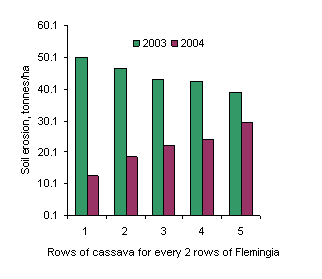
Figure 13: Soil erosion in plots with varying ratios of
Flemingia to cassava in the two years
Soil cover is an important factor in control of
erosion by water through interception and absorbing the kinetic energy in the
rain. The soil cover reduces the direct impact of the rain drops and prevents
the surface from becoming sealed as well as preserving the soil structure.
Andersson (2002) compared plots with monoculture of cassava or Flemingia and
reported that in the second year, soil loss in the former was 34 tonnes compared
with only 5.4 tonnes/ha for the Flemingia. Nguyen Phuc
Tien et al (2003) also
found that soil fertility was maintained over two years in plots inter-cropped
with Flemingia and cassava in equal proportions.
Conclusions
-
Biomass yield of cassava and Flemingia in an inter-cropping system was improved by increasing the number of cassava rows relative to cassava in the first year, but decreased slightly in the second year. The maximum biomass yield was obtained in the system with 2 rows of cassava and two rows of Flemingia.
-
The crude protein contentof the cassava foliage deceased as the area of cassava rlative to Flemingia increased.
-
Soil fertility over a 24 month period increased in the plots with the highest ratio of Flemingia and decreased as the ratio of cassava to Flemingia was increased.
-
Protein content in the cassava foliage decreased linearly with decreased in soil fertility.
-
Soil erosion was high in all plots in the first year and was directly related to the relatve area planted with Flemingia. In the second year soil eroson was much less and was inversely related to the proporton of Flemingia in the inter-cropping system.
-
The optmum ratio of Cassava to Flemingia, in terms of biomass yield and maintenance of soil fertility, is two rows of each planted alternately.
Acknowledgements
The Senior Author acknowledges the support of the International Foundation of Science (IFS) for financing this research (Grant No. B/3085-1).
References
Andersson J 2002 Possible Strategies for
Sustainable Land Use in the Hilly Area of Northern Vietnam. Swedish University
of Agricultural Sciences, Department of Soil Sciences, Division of Agricultural
Hydrotechnics, S-750 07 Uppsala, Sweden
AOAC 1990 Official methods of Analysis. 15th
Edition. Association of Analytical Chemist, Washington D C
Binh D V, Tien N P and Mui N T 1998 Study on
biomass yield and quality of Flemingia macrophylla and on soil
fertility. Proceeding on Workshop of Animal Nutrition Science, Ministry of
Agriculture and Rural Development, Vietnam, pp.137
Boonchan Chantaprasarn and Preston T R 2004:
Measuring fertility of soils by the bio-test method. Livestock Research for
Rural Development. Volume 16, Art. #78. Retrieved
, from
http://www.cipav.org.co/lrrd/lrrd16/10/chan16078.htm
Dzowela B H, Hove L, Topps J H, Mafongoya P L
1995
Nutrition and Anti-nutrition characters and rumen degradability of dry matter
and nitrogen for some multipurpose tree species with potential for agroforestry
in Zimbabwe. Animal Feed Science Technology 55, 207-214
Dzung N T, Binh D V, Mui N T and Preston T R 2003
Improving biomass yield of cassava (Manihot esculenta
Crantz) and soil fertility through mixed culture with Flemingia(Flemingia
macrophylla). Cassava hay as protein source for lactating goats: Research
grant report, No. B/3085-1.
Huy L K, An L V, Ly N T H, Dao T P
and Toan N H 2000
Using the leguminous forages as protein source for feeding animals in small
upland farming systems. In: Proceeding of National Workshop on Sustainable
Livestock Production on Local Resources. University of Agriculture and Forestry,
Thu duc, Ho Chi Minh City, pp1-4
Khang D N and Wiktorsson H 1999
Effect of
cassava leaves meal rumen environment of local yellow cattle fed urea-treated
paddy straw and ruminal dry matter degradability of some local available feeds.
MSc. Thesis, Uppsala 1999. ISBN 91-576-5671-1
Lancaster P A and Brooks J E 1983 Cassava
leaves as human food. Economic Botany 37(3), 331-348
Minitab 2000 Minitab Release 13.1 for
windows, Windows* 95/98/2000. Copyright 1999, Minitab Inc, USA
Mui N T, Preston T R, Binh D V, Ly L V and Dzung
N T 1996 Effect of planting season and type of fertilizer on biomass yield
and quality of sugar cane. Livestock Research for
Rural Development, Volume 8, Number 4,
November 1996
Mui N T, Ledin I, Udén P and Binh D V 2002
Effect of replacing a rice bran-soya bean concentrate with Jackfruit (Artocarpus
hererophyllus) or Flemingia (Flemingia macrophylla) foliage on the
performance of growing goats. Livestock Production Science 72 (2001), 253-262
Nguyen Phuc Tien, Ngo Tien Dung, Nguyen Thi Mui,
Dinh Van Binh and Preston T R 2003 Improving biomass yield and soil
fertility by associations of Flemingia (Flemingia macrophylla) with
Mulberry (Morus alba)
and cassava (Manihot esculenta) on sloping land in Bavi area. In:
Proceedings of Final National Seminar-Workshop on Sustainable Livestock
Production on Local Feed Resources (Editors: Reg Preston and Brian Ogle).
HUAF-SAREC, Hue City, 25 - 28 March, 2003. Retrieved , from
http://www.mekarn.org/sarec03/tienbavi.htm
Phuc B H N, Ogle B, Lindberg J E 2001
Nutritive value of cassava leaves for monogastric animal. International Workshop
Current Research and Development on Use of Cassava as Animal Feed. Khon Kean
University, Thailand, July 23-25, 2001
Polthanee A, Wanapat A, Wanapat M and
Wachirapokor C 2001 Cassava-Legumes intercropping: A potential food -feed
system for dairy farmers. International Workshop Current Research and
Development on Use of Cassava as Animal Feed. Khon Kaen University, Thailand,
July 23-25, 2001
Preston T R, Rodriguez L and Khieu Borin 2000
Associations of cassava and legume trees as perennial forage crops for
livestock. Workshop-seminar "Making better use of local feed resources" January
2000. SAREC-UAF
Preston T R 2001 Potential of cassava in
integrated farming systems. International Workshop Current Research and
Development on Use of Cassava as Animal Feed. Khon Kean University. Thailand,
July 23-24th, 2001
Ravindran V 1991 Preparation of cassava leaf
products and their use as animal feed. FAO Animal Production and Health Papers.
APHP 95: Roots, tubers, plantains and Bananas in animal feeding.
Rogers D J 1959 Cassava leaves protein.
Economic.Botany.13, 261-263
San Thy and Preston T R 2000 Cultivating cassava (Manihot
esculenta) as perennial forage for goats, effects on foliage yield and
composition of variety, associations with shrub legumes and recycled biodigester
effluent. Livestock Research for Rural Development. (13) 2,
http://www.cipav.com.org/lrrd/lrrd13/2/sant132
Wanapat M, Wachirapakorn C, Chanthai C and
Sommart K 1992 Utilization of cassava leaf (Manihot esculenta Crantz) in
concentrates mixtures for swamp buffaloes in Thailand. Proc. Feeding Strategies
for Improving Ruminant Productivity in Area of Fluctuation Nutrient Supply
FAO/IAEA, Vienna, Austria
Wanapat M, Pimpa O, Petlum A and Boontao U 1997
Cassava hay: A new strategic feed for ruminants during the dry season. Livestock
Research for Rural Development (9) 2:
Http://www.cipav.org.co/lrrd/lrrd9/2/metha92.htm
Wanapat M, Puramongkorn T and Siphuak W 2000 Feeding of cassava hay for lactating dairy cows. Asian-Australasian Journal of Animal Science 13, 478-482

